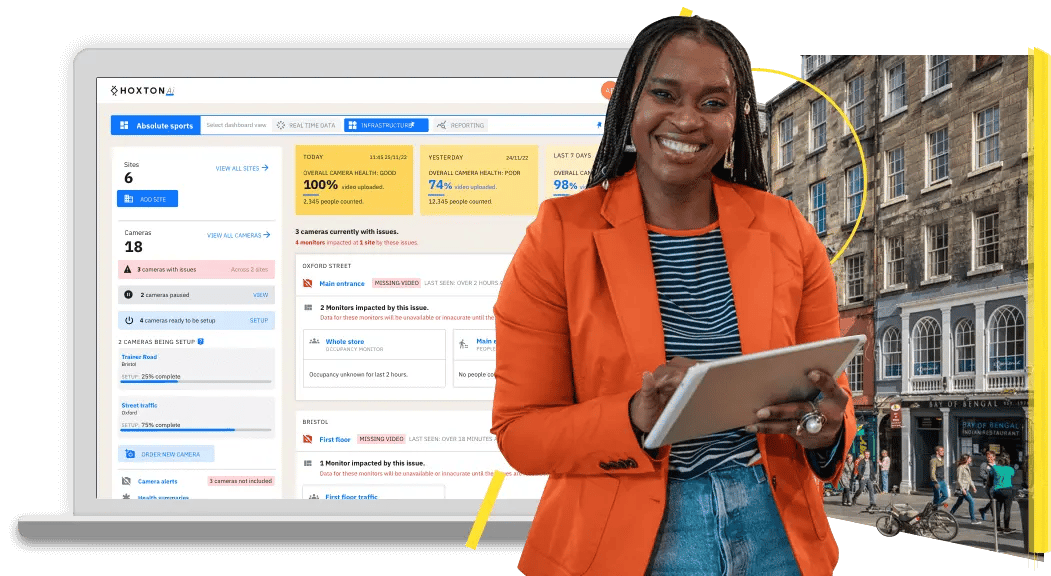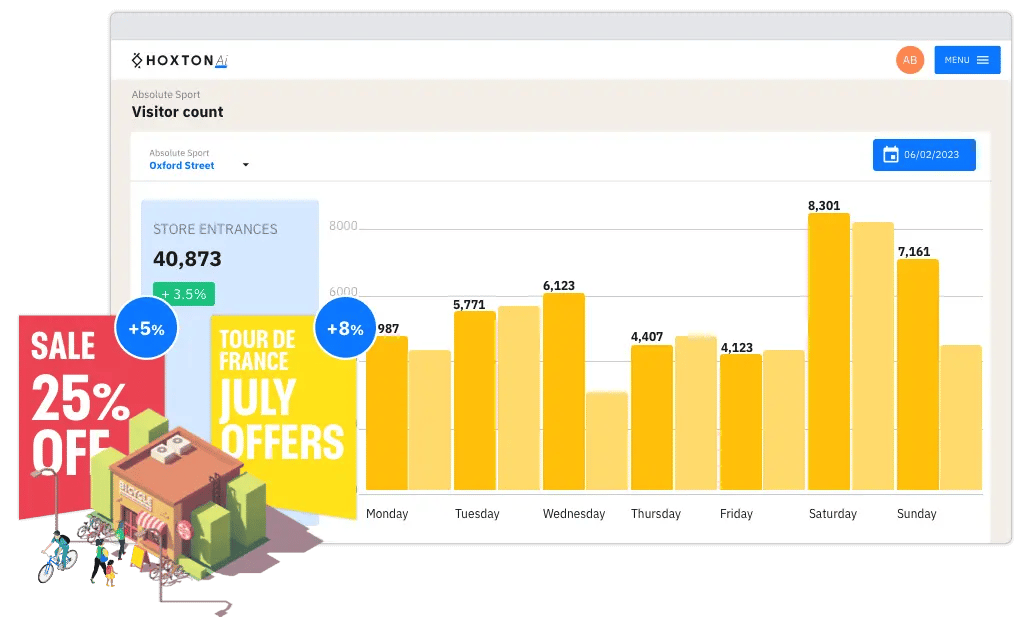At HoxtonAi, we speak to hundreds of retailers about their store management, data requirements and the practical, day-to-day impact of the data on their business.
Most retailers monitor in-store footfall, conversion rates and may even be utilising a system like ours, giving them a digital view of the customer journey- from street traffic to paying customer.
It is very common, however, to see systems and data underused. The most advanced companies integrate the data deeply into their operations, and to do this, it’s paramount to set the right goals, to ensure success in the areas most important to your stores.
One useful methodology to set and monitor goals that we've seen used very effectively, is the OKR framework- introduced by Intel in the 90s as an effective, ambitious way to set and beat targets. In this blog, we set out how retailers use this framework to help embed data-driven decisions and best practices in their business.
The Objectives and key results (OKRs) framework
The framework is primarily composed of two elements. Objectives, which are what the organization is looking to achieve, and, the key results, the measurable factors we believe will lead to success in the relevant objective. Typically it's advised to have around three objectives, each with 3-5 key results.
Using this framework allows teams to align towards clear common goals, bringing greater focus to the most important tasks at any given time. Its simplicity and measurability also improves the visibility of progress, by drawing attention to the most important metrics (key results), and produces increased accountability, by making sure everyone understands which key results they have responsibility for or influence over.
Setting Objectives
You may arrive at an objective in any number of ways, perhaps a rough objective has come from above, or maybe it was the outcome of some analysis you carried out by yourself or your team. Regardless of the source, these objectives need to be ambitious but achievable, and they should align with the overall strategy of the business.
In the context of retail, objectives could include increasing sales revenue, improving customer satisfaction, or reducing costs. That being said, the most common objective our clients have is to increase profits by a specific amount during a given period.
Let’s say then, for example, that after analyzing footfall, sales, and conversion data and then having had discussions internally you decide and agree with your team on the following objective:
Objective 1: Increase sales by 10% at our Covent Garden store in Q2.
Uncovering Key Results
Next comes the key results. They need to be specific, measurable, time-bound, and should be clearly aligned with the overall objective. In our example, we could include key results centered around increasing the footfall in-store or increasing the number of people that make a purchase. However, it turns out that looking at footfall and sales data alone is far from optimal.
It’s better to use ‘conversion rates’ as they’re able to account for the amount of opportunity you had to convert people visiting the store into paying customers or, from passersby into in-store visitors. This is one of the reasons retailers often monitor an in-store conversion rate and we also recommend monitoring a street-to store conversion rate, or capture rate, for each of your stores. This nuance is explained in detail in our article 'Why footfall isn't the end-all'.
With that in mind, you conduct some further analysis to get even more specific on the areas that you think will have the biggest impact on your objective. You find that, although there are a good number of people entering the store on weekday evenings, they aren’t currently converting very well. You also notice that on Saturdays, your capture rate, the proportion of people coming into the store from the street, is lower than you’d expect. From here you design the following key results that you believe, if achieved, will mean you’ve reached your objective:
Key result 1: Increase in-store conversion rate on weekday evenings at the Covent Garden store by 5% in Q2.
Key result 2: Increase street-to-store conversion rate on Saturdays at the Covent Garden store by 7.5% in Q2.
We may also choose to take into account a range of other important metrics outside of footfall such as average basket size or the known profitability of specific items. For example, we could also set up the following key result:
Key result 3: Increase the average basket size at the Covent Garden store by 10% in Q2
What happens next
Once you’ve come up with your objectives and key results share them with the relevant stakeholders so that teams and individuals are able to create a game plan of how they’re going to contribute to the results relevant to them. This ensures that everyone is aligned, and understands the goals as well as their individual responsibilities toward achieving them.
Now it’s time for action. This involves implementing the necessary changes to improve your targeted metrics and regularly tracking progress against the key results. It’s important to review progress regularly with your team, ideally on a weekly or fortnightly basis, and make any necessary adjustments to keep things on track.
In our example this might involve realizing we need to increase the number of staff during weekday evenings (for key result 1), using our window displays to better show a promotion that’s currently running (for key result 2), or providing extra sales training to improve the branch staffs ability to upsell (for key result 3). It’s important to celebrate wins and share progress updates across teams along the way to keep everyone motivated and engaged in the process.
In conclusion, it’s easy to see why the OKR framework is such a powerful goal-setting tool. It brings clarity to what is most important and empowers all to contribute towards collective success. In the context of retail, combining this with the powerful insights that come from people count technology, we’re able to help our clients drive success across their store portfolio, taking a data-driven approach each step of the way.
Recent Articles
How real-time footfall data helped a Telco Franchisee drive a 20% increase in revenue
Duncan Mann | Oct 2024
Background: the importance of sales conversion rate
Read moreCase Study: How fashion retailer GOOD uses the HoxtonAi Retail Report to improve accountability and increase conversion across their stores.
Owen | Jun 2023
“The retail report has been a game-changer. Each week, we discuss the footfall and conversion ...
Read moreOn the accuracy of retail footfall counters
Owen | May 2023
In retail, footfall-related metrics have become cornerstone data points used to track various ...
Read moreThe OKR goal setting framework: how to drive success in retail
Owen | Apr 2023
At HoxtonAi, we speak to hundreds of retailers about their store management, data requirements and ...
Read moreHow combining different types of footfall data can build a digital view of physical stores
Owen | Apr 2023
One of the biggest differences between optimization in online and physical retail spaces is the ...
Read moreWhy footfall isn't the end-all. What to do about the retail data gap.
Owen | Apr 2023
In our experience, we’ve found that most retailers are familiar with the idea of monitoring ...
Read moreThe Main Challenges for Retailers in Fully Leveraging Footfall Data
Owen | Mar 2023
In today's digital age, data has become a valuable asset for businesses looking to optimize their ...
Read moreWhat We Talk About When We Talk About Retail Footfall
Owen | Mar 2023
The soft side of cold, hard data We’ve released content on the ‘hard’ aspects of using data to ...
Read moreTop 6 Essential KPIs & Metrics in Retail
Owen | Mar 2023
As retail technology has evolved, we have found better ways to measure, track and compare ...
Read moreWhat is Conversion in Retail? And How to Measure it in a Physical Store?
Owen | Mar 2023
What is a conversion rate? A conversion rate is typically considered to be the percentage of people ...
Read moreHow to use Footfall Analytics to Improve Store Performance
Duncan Mann | Mar 2023
Before we get started, for a quick reminder of what 'people count' and 'footfall' mean, check out ...
Read moreWhat We've Found Analysing Footfall Data in Retail
Duncan Mann | Mar 2023
5 Trends We've Noticed... "At HoxtonAi, we work with customers to ensure their data is high ...
Read moreClosing the data gap between online and physical retailing
Owen | Mar 2023
As shoppers continue to return to the high street post-pandemic, physical stores need to catch up ...
Read moreAn Introduction to People Counting in Retail
Owen | Mar 2023
What is people counting? Simply put, people counting is the act of counting the number of people ...
Read moreCase Study: How Center Parcs Use Occupancy Data To Drive Better Guest Experiences.
Duncan Mann | Aug 2022
We initially trialled the HoxtonAi solution on a small scale to ‘kick the tyres’ and see if it’s a ...
Read more